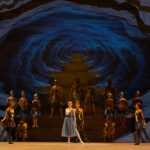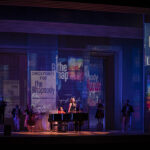In 2015, when Savannah Ballet Theatre mounted its first production of Hans Christian Andersen’s The Little Mermaid, artistic director Suzanne Braddy and educational director/choreographer Abby McCuen began to think about ways to make the stage setting as exciting as the dancers’ fluid movements.
The company has two costume designers, Siobhan McGrath and Milla Wilkes-Davies, who created glittering, flowing garments that flash and sparkle as the fairly tale’s underwater characters twirl across the stage. The dancers themselves — 13 professionals and 36 students and community members — tell the mermaid’s tragic story (this is Andersen’s original tale, not Disney’s Hollywood retelling) with thrilling choreography and plenty of drama. Still, McCuen felt that one important element was missing in this initial production.
“Having those flat canvas drops…the theatre didn’t move,” she said. The ballet company performs in the historic Lucas Theatre for the Arts in downtown Savannah, GA, an art deco-era movie theatre converted for live theatre in the 1930s and extensively renovated in the 1990s. With its genesis as a 1921 movie house, the Lucas was uniquely suited for the Savannah Ballet Theatre to try something new for its remounting of The Little Mermaid in spring 2018: projected scenery.
“We have fantastic dancers, but people who come to a show want to be entertained at the next level,” said McCuen. On a limited budget, however, she worried that her options would be very restricted.
Luckily, her online search for affordable projected scenery led her to Mitch Stark at Theatre Avenue, an independent scenic artist based in Atlanta. Stark has dedicated his business to providing affordable projections to small to mid-sized performing arts companies.
“I contacted Mitch, not really knowing what I was in for,” McCuen said. Were there any options the Savannah Ballet could afford? Would she need to rent expensive projection equipment and hire someone trained in the technology? Could she get animated or video projections — and if so, how would the timing work in live performance?
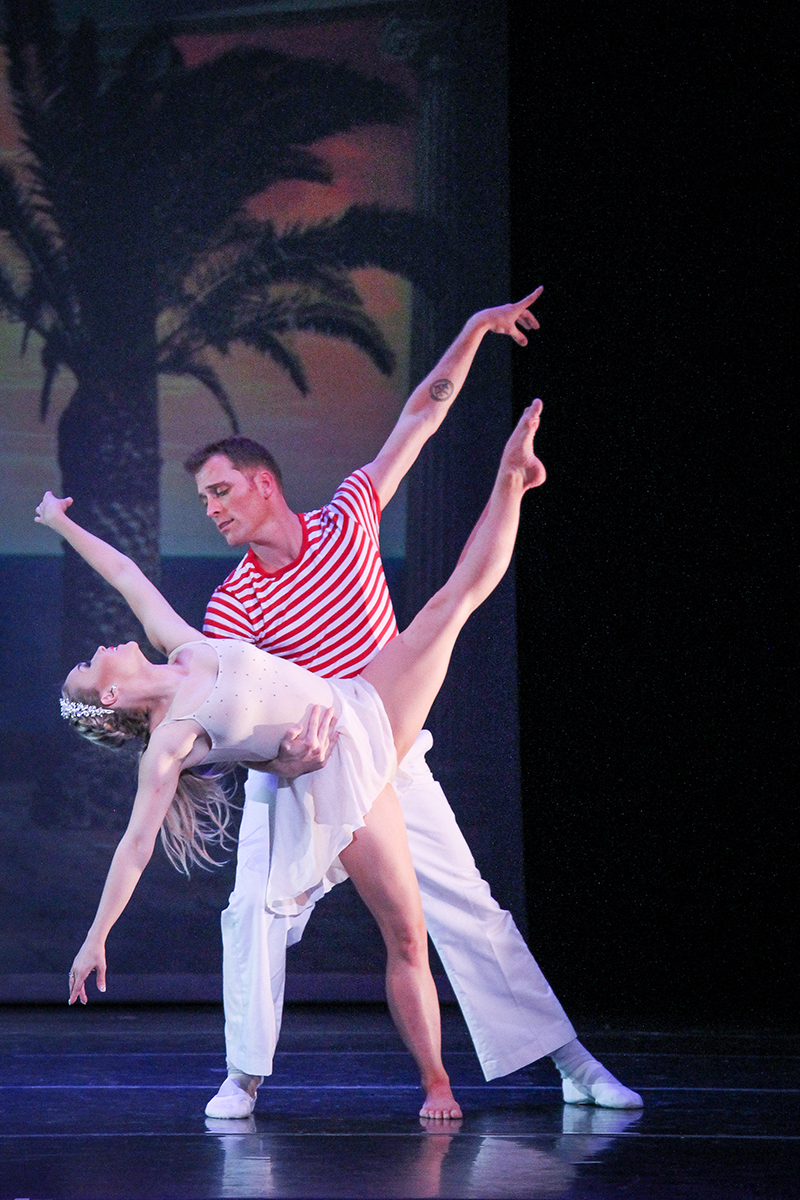
Big Designs for Small Companies
Stark was prepared for exactly these questions. With a decade of experience in non-profit theatre and ballet, he knew what concerns small companies had when approaching the use of new technology on their stages.
A graphic artist by training, Stark examined the world of theater design for the first time while he pursued a career in marketing and illustration. When a friend started a theatre company for at-risk children in Alabama, Stark provided the communications materials she needed, but soon he saw the opportunity to do something on a larger scale — designing scenery that she could project onto a blank canvas behind the students during performances.
“The first production we did together was Joseph and the Amazing Technicolor Dreamcoat,” Stark recalled. “She said, ‘I have this 30-by-35-foot area where I’d like to put something up.’ I had no awareness of projections, but she said, ‘If we projected something back there, it would sure be better than nothing.’ So, we did that, and it was great. I started doing this on a volunteer basis.”
Over time, Stark designed, painted and digitized enough scenes that he decided to set up an online store and provide his projections to companies beyond his friend’s theater. That was five years ago, and he has continued to build inventory in earnest since then, now providing more than 100 digital backdrops to companies throughout the U.S. and beyond.
“It’s really been a fun ride,” Stark said. “I’m working with ballet and dance companies, including international shows. A director took his production of Swan Lake to Japan, and he did not have the money or ability to ship big drops overseas. Projections were a great solution.” Carrying scenery on a flash drive instead of on buses and trucks obviously saves money, while alleviating a great deal of anxiety for companies that perform globally.
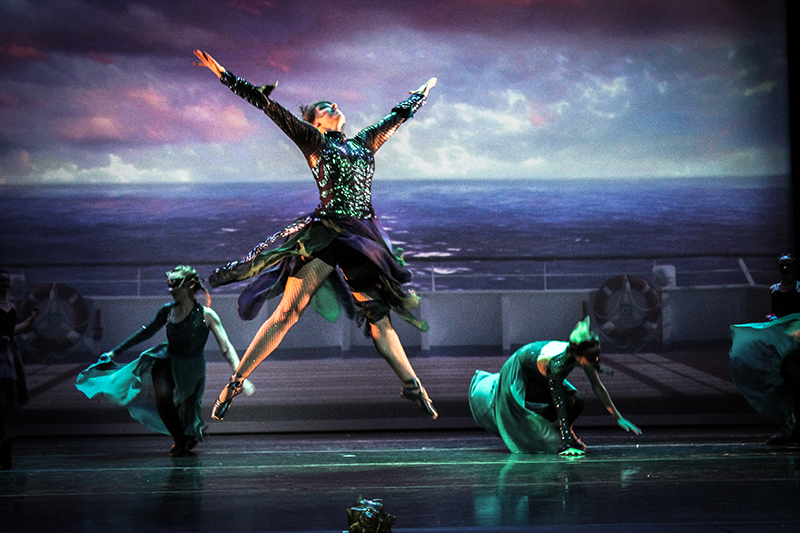
A Classical Approach for Mermaid
Stark formed an area of specialization with ballet companies. “Ballet directors don’t want anything on stage; they want it open for the dancers. Projections really have a home there,” he observed. This format lends itself nicely to sophisticated design. “Ballet in itself has a level of artistry and a maturity of the art, and a certain level of digital art won’t stand up in that environment.”
“I’ve worked with designers in the past, and I’ve always given them creative liberty,” said McCuen. “Mitch was really interested in what inspired us, what moved us, so he could get on the same page with us. So I sent him a video of the 2015 version, and he saw what we were doing — the music, the costumes, the dancing.”
Stark and McCuen pooled their creative talents to determine the best approach to telling the story Hans Christian Andersen imagined back in 1836. “For The Little Mermaid, you can depart from what people know from the Disney version, and go back to more classical fairy tales,” said Stark. “When I dive into the concept research, it gives me the ability to go back to old book illustrations or covers, and find older imagery that feels like it has a fairy tale element to it. We went to classical paintings and I built a palette of color swatches, and then we brought in the modern technique. This lets us emphasize the storytelling.”
With a visual theme, color palette, and agreement from the team about design parameters, Stark and McCuen turned first to Theatre Avenue’s existing inventory to see if anything already created would be a good fit. “There were a couple of existing projections in our store that Abby liked that fit into our design concept,” said Stark.
An underwater palace projection from Theatre Avenue’s stock uses deep blues, faintly glowing castle spires and an overall murkiness that suggests a mysterious bottom-of-the-sea realm. “The water is moving behind the palace,” said McCuen. “We really liked the animated backdrop.”
Further perusal revealed the perfect setting for the witch’s lair. “Mitch had the right thing — it looks like the inside of a whale,” said McCuen. Here the whale’s teeth, glowing in an eerie midnight blue, surround a ghastly green throat, making it clear that the evil witch’s den resides in the belly of the great beast.
With these two scenes in place, Mitch went to work to draw and paint the above-ground scenes. “One was the ship deck, where the Little Mermaid sees the sailor,” said Stark. “The 2015 version Abby had done had kind of an Anything Goes ship on a painted drop. I talked to her about minimizing the amount of deck space that we see. There’s a little bit of deck and railing in the projection; there’s sun and clouds built on video loops, and I have a full storm, where we did animated water with rough seas. I built a transition to go from daytime to the storm, so the clouds roll in and the sea gets choppy.”
This created a deliberate dichotomy between the stylized, fanciful underwater scenes and the near-photographic reality of the scenes at the water’s surface and on land. “I’m thinking, we can do everything stylized, like the cover of Charlotte’s Web, or we can have Annie, where it’s gritty and photo-real,” said Stark. “In this show, we found reasons to do both.”
Stark finished the design with a boardwalk, using Roman columns on either side and an animated ocean, as well as a more generic underwater scene for locations that were not at the palace. “For that one, I brought in some of the caustic light rays that come through the water,” he said.
“In all, Mitch did four or five custom projections for us,” said McCuen. “A week after we approved the concepts, they were drawn and colored and ready to go.”
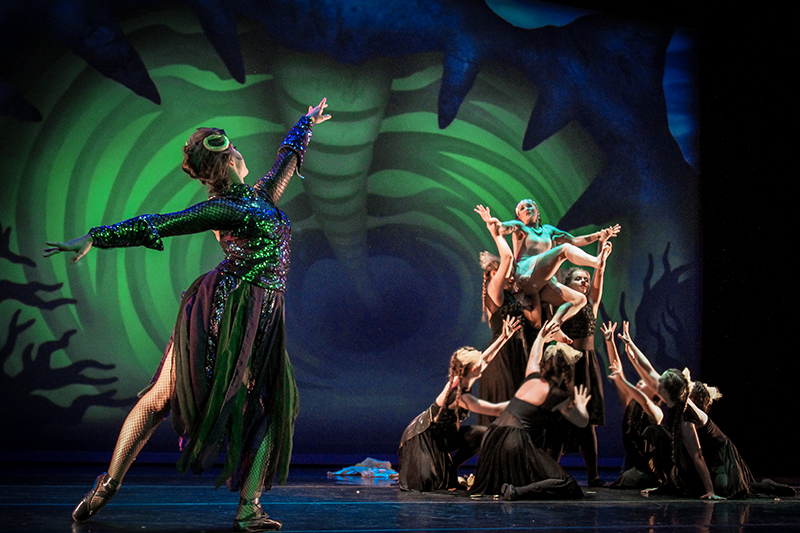
Execution with Simplicity
Stark consulted with Savannah Ballet Theatre about the equipment they would need to project the scenes properly. McCuen discovered that the projector rental still made the projections considerably less expensive than renting or creating a package of painted canvas backdrops.
“We rented a 14K projector” — the Christie HD14K-M 1080 HD 3DLP projector — “which would cost about $40,000 to buy,” she said. “We rented it from a local tech house that does all the technical things around town. They knew the theatre and knew exactly what we needed.”
When she received the digital files from Theatre Avenue, McCuen turned them over to the technician who ran the projector. “He took all the projections, put them together, did the timings between them, and set the whole thing up for us,” she said. “Usually we have a union stagehand — which also costs money — so this time we were lucky not to need that expense.”
Running a show with hanging painted drops always required an additional stagehand to handle the rigging system, she noted — at an additional cost for rehearsals and performances.
Altogether, the projections — including Stark’s design time — plus the projection equipment and technician cost Savannah Ballet Theatre a scant $3,500, about half the cost of a rental of seven painted backdrops and the labor to run them.
“I got a lot of great feedback about the drops,” said McCuen. “We are using projections from here on out. It just really makes it that much better.”
The ability to open up the creative possibilities for smaller companies while actually saving them money is one of the most attractive benefits of his field, Stark concurred. “Projections level the playing field — that’s what I love about them the most. They allow directors to imagine without limits.”
Randi Minetor is a freelance journalist and author based in upstate New York.
